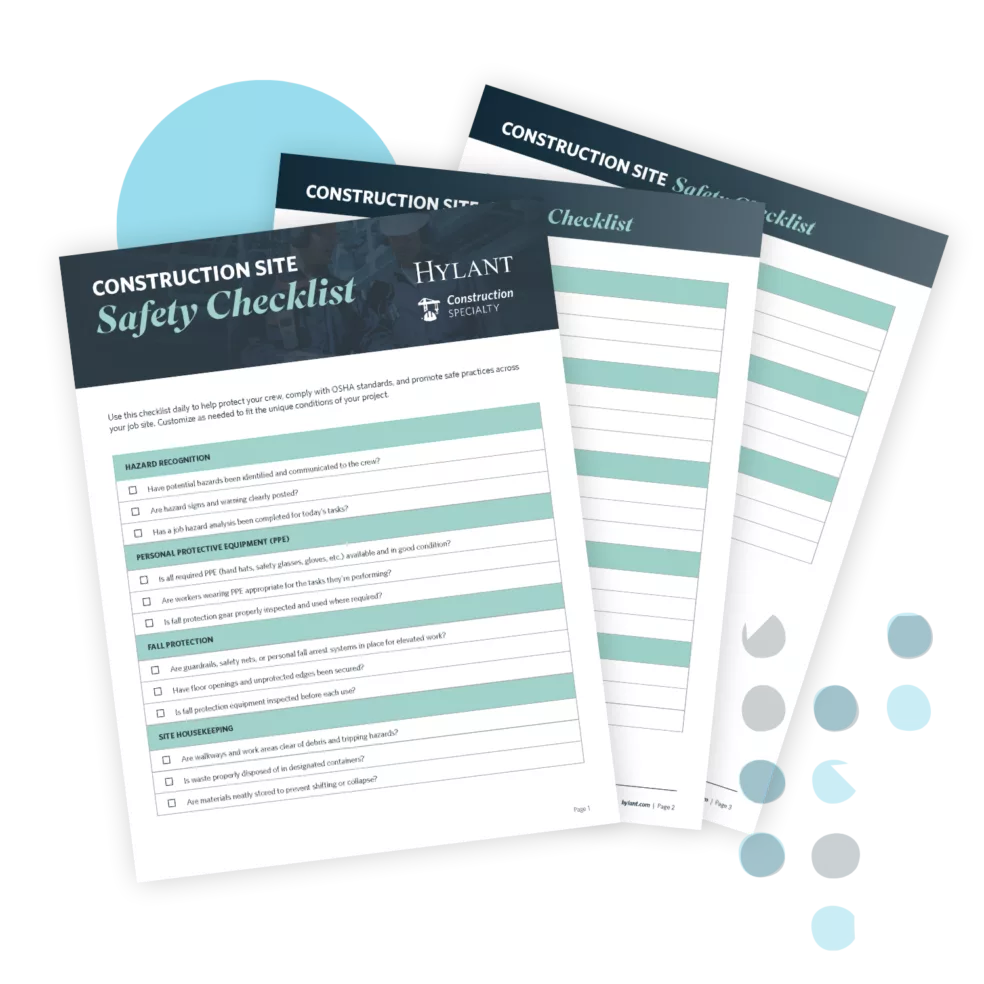Construction
9 Ways to Improve Construction Site Safety
July 10, 2025
Les Temple knew the heavy extension ladder was out of balance, but he only planned to climb about 8 feet, so he didn’t give that a second thought. When he reached over to insert the last fastener, his center of gravity shifted, and the ladder tipped. Les never guessed he’d end up in an ambulance or spend three months at home as his bones healed. He didn’t realize how lucky he was, because even a short fall can lead to disabling injuries or death.
Most construction injuries are preventable if employees use safe practices. Whether that involves lifting properly, wearing fall protection on elevated services, or being willing to call out a co-worker who is doing something they shouldn’t, construction workplace safety saves lives -- and it protects employer profitability. Safe workplaces typically have higher levels of productivity and morale, which means valued workers are less likely to leave for other employers. The best workers prefer to be at the safest construction companies.
Why is Safety Important in Construction?
Nobody wants a worker to suffer any kind of harm while working for them -- especially life-changing injuries or fatalities. But the simple fact is that many types of work are inherently dangerous. In the U.S., more than 4,700 workers died at work in 2020 (the most recent statistics). Federal OSHA construction safety data reports construction, mining, transportation and moving materials accounted for nearly half of fatal workplace issues.
According to the National Safety Council (NSC), the total cost for U.S. workplace injuries in 2021 was $167 billion. In addition to medical costs and work time lost by insured workers, that includes the time supervisors are forced to devote to investigating and reporting injuries. The NSC adds that injuries requiring medical consultation cost an average of $42,000 to treat, and worker deaths average a cost of $1.34 million. Preventing injuries and deaths can dramatically reduce costs while enhancing productivity and morale.
OSHA Safety Requirements for Construction
Some employers speak negatively about OSHA job site requirements and what happens when an inspector shows up on a construction site. But it’s impossible to overlook the success the federal workplace safety organization has had in protecting American workers. In its half-century of existence, the average number of workplace deaths has dropped from roughly 38 a day to 13. Injuries and illnesses have also declined significantly, dropping from a rate of 10.9 incidents per 100 workers to 2.7 per 100.
9 Construction Safety Tips
What is construction safety? It’s a comprehensive process of assessments, planning and measures to protect the health and well-being of workers on a construction site, as well as prevent damage to buildings, equipment and the surrounding area. Construction site safety management focuses on identifying and addressing risks. It’s built on the knowledge that most workplace injuries are preventable. Typically, serious injuries happen when someone fails to follow safety practices and policies.
Knowing these construction safety tips is a great starting point.
1. Create a Site Safety Plan
The first step in ensuring construction workplace safety is to develop what’s known as a construction site safety plan. Safety plans for construction include:
- A thorough description of the project scope
- Review of the site itself
- Details of tasks to be performed
- Safety risks associated with the site and tasks
- Measures to be taken
- Company policies and practices regarding safety
The objective of a plan is to ensure everyone understands the project, expectations, risks and their own role in construction safety.
2. Wear Construction PPE
Many tasks on construction sites include hazards that can be mitigated by wearing personal protective equipment (PPE) such as protective eyewear, gloves, steel-toed work boots and hard hats. The safety plan should spell out when PPE is needed.
3. Jobsite Safety Training
A key element of safety guidelines for construction workers is regular, ongoing training. The better workers understand the hazards associated with specific tasks, OSHA standards for construction and how safety measures at construction site protect them, the more they’ll comply.
4. Provide Clear Instructions
To ensure safety for construction workers, they need to understand their role in jobsite safety. Making sure they have written operating procedures and posting safety precautions is critical.
5. Keep the Job Site Clean
When addressing housekeeping’s role in safety plans for construction, it’s more than a matter of regular sweeping. Housekeeping involves everything that can be done to mitigate hazards in the physical environment, from how work areas are arranged, to eliminating slip and trip hazards, to storing materials safely. There’s a direct correlation between worker attitudes about safety and their working conditions.
6. Store Tools Correctly
As part of on-site safety, all tools and equipment must be properly stored. Workers should not leave tools scattered around the work site.
7. Use the Right Equipment for Each Job
Sometimes construction workers won’t want to take the time to get the right equipment for a task and will try to use something in its place. Such workarounds rarely provide to be either effective or safe.
8. Service Tools and Equipment
OSHA job site requirements include properly maintaining tools and other equipment to ensure they work properly and all protections are in place.
9. Report Issues Immediately
A safety plan for a construction company needs to spell out exactly what workers should do when they encounter a problem or when someone is injured, even slightly. Workers should know who to contact and make that contact without delay.
Construction Site Safety Checklist
An effective way to verify safety precautions on a construction site is to use a building site safety checklist—or better yet, multiple checklists. Each hazard deserves its own list as an ongoing reminder of the importance of safe construction. Checklists make safe work practices routine, help document OSHA compliance, and cover everything from inspecting tools to verifying PPE to considering effects on the surrounding area.
No two construction sites are alike, so checklists should be tailored to the project and its unique safety issues. Construction worker safety depends on understanding hazards and taking steps to prevent injuries. Download our checklist today and put your safety plan into action.

Work with Your Insurance Broker
Your insurance broker is an excellent source of construction safety resources. Hylant’s dedicated construction industry insurance team works with contractors, construction companies and building owners to understand and address their risks from an insurance perspective. Working with our clients, we minimize the potential financial and reputational impacts of issues on construction sites, creating peace of mind while meeting legal requirements. Contact Hylant today to discuss your construction business insurance needs.
Related Reading: Trenching and Excavation Safety
The above information does not constitute advice. Always contact your insurance broker or trusted advisor for insurance-related questions.


